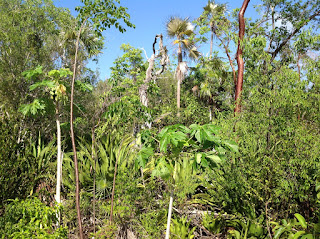Cayman Nature Tours
Colliers
Wilderness Reserve is a National Trust for the Cayman Islands protected area,
secured through a European Union grant-funded project entitled Management of Protected Areas to Support
Sustainable Economies (MPASSE).
There
is a short, easy-walking loop trail through original-growth dry rocky woodland
(phytokarst) where many different species of Cayman's plants may be seen –
trees, shrubs, vines, cacti, orchids, mistletoes (called Scorn-the Ground in
Cayman), also well as fungi, lichens, birds and other creatures.
European
Union representatives visited Cayman in November 2016 to assess the progress.
Phytokarst
is pinnacle rock of the Cayman Formation dolostone (limestone with
magnesium). Roots of trees and shrubs penetrate through the rocks to get water.
The roots secrete acids. Microbes bore their way into dolostone to
produce the sharp, grey-black weathered surface of the jagged pinnacles which
contrasts with the white colour of the unaltered host rocks.
Corato - Agave caymanensis, Cayman Islands endemic,
on the Colliers Wilderness Reserve loop Trail, May 4, 2016
Click here for more photos:
Colliers Wilderness Road under construction, Sept. 25, 2011
Colliers Wilderness Road under construction, Sept. 25, 2011
Blue Iguanas have more room to roam
The National Trust for the Cayman Islands purchased the land last month for $318,000. Two thirds of the purchase price was provided from a more
than 700,000 euro (CI$850,000) grant
from the European Union and one third from the National Trust through a
donation from Maples Finance, said
the Trust’s chair, Carla Reid.
CaymanCompass By Norma Connolly - October 27,
2011
The EU grant for sustainable tourism
projects is shared with the Cayman Islands,
Turks and Caicos and the British
Virgin Islands.
Grand Cayman Blue Iguana - Cyclura lewisi - Grand Cayman endemic, Aug. 18, 2013
Lily Thorn - Catesbaea parviflora, Sept. 25, 2011
Lily Thorn - Catesbaea parviflora, Sept. 25, 2011
Cayman Scolosanthus - Scolosanthus roulstonii, Grand Cayman endemic, Feb. 19, 2012
Cayman Scolosanthus - Scolosanthus roulstonii, Grand Cayman endemic
(Little Salt Creek bluff, Sept. 27, 2006)
(Little Salt Creek bluff, Sept. 27, 2006)
Colliers Wilderness Reserve Road, Feb. 19, 2012
Ironwood - Chionanthus caymanensis, Cayman Islands endemic
Entomologist Dr. R. R. Askew photographing
Duppy Cap, Lattice Stinkhorn fungus - Clathrus crispus, Family: CLATHRACEAEThe fruiting bodies pop up in lawns and other areas, often by former tree stumps. They smell foul and attract flies.
Range: Florida, the Gulf Coast, the Caribbean, and Mexico.
Photo: P. Ann van B. Stafford, Grand Cayman, Nov. 5, 2015.
http://www.mushroomexpert.com/clathrus_crispus.html
The
Colliers Wilderness Reserve entrance is about a mile inland
from the coastal East End road - Austin Conolly
Drive.
L to R:
Fred Burton, Stuart Mailer, Aljoscha Wothke - team leader of the final evaluation of the EU MPASSE project (Management of Protected Areas to Support Sustainable Economies), Paul Watler, Ann Stafford, Clare Lumsden, Cathy Childs, Dennis Chong (civil engineer).
Photo: Christina McTaggart Pineda, Grand Cayman, Nov. 22, 2016.
Photo: Christina McTaggart Pineda, Grand Cayman, Nov. 22, 2016.
Photo: Ann Stafford, Grand Cayman, Nov. 22, 2016.


























No comments:
Post a Comment